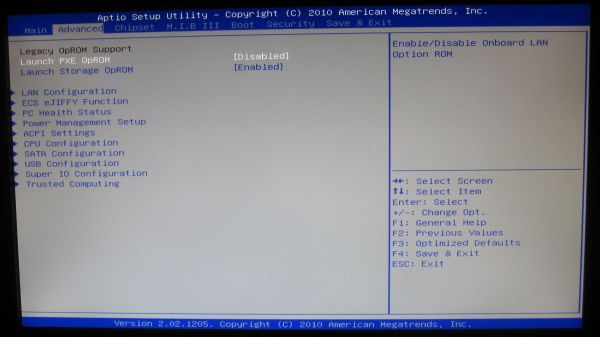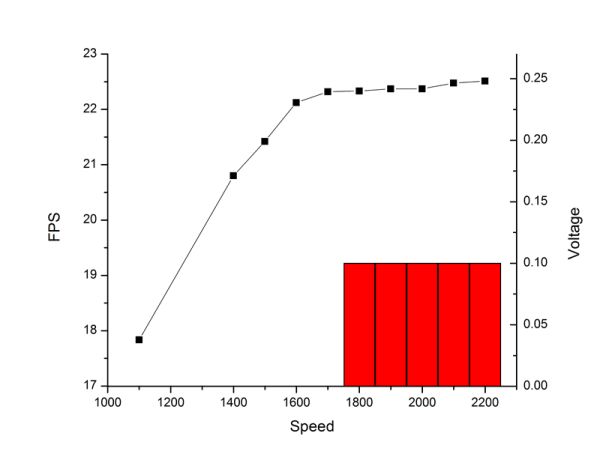H67 – A Triumvirate of Tantalizing Technology
by Ian Cutress on March 27, 2011 6:25 PM EST- Posted in
- Motherboards
- Sandy Bridge
- H67
BIOS
Out of the Sandy Bridge chipset UEFI/BIOSes I have seen so far, the ECS implementation, whilst functional, is not breaking any new ground. In actual fact, it can be a bit of a pig to use. It is not always obvious where options are for a start.
There is no main screen to see what you have got installed, what voltages are being applied, what temperature it is running at, what DIMMs you have installed, etc. The best is this screen shown above, which gives the processor, some voltages and total memory. There is another screen with similar information and the ‘system temperature’, which could either be the CPU, or the Chipset, or an average of the two.
The smart fan options give you Normal/Quiet/Silent/Manual, and all the options above (except CPU Fan Full Speed Offset) can be changed. There is no high performance option if you want/need the fan on full all the time however.
A lot of the BIOS options are embedded in the Advanced Menu, and in one of the subsequent sub-menus within. A lot of these sub-menus have a single option or two, meaning that there is constant flicking between them if you want to check every system setting. Not exactly the best way of organizing a BIOS in my opinion – and seasoned BIOS users are used to pressing F10 on almost all motherboards as the button for ‘Save and Exit’. ECS have confusingly set this to F4.
One positive option I like in the BIOS, which is not available in various UEFIs such as the ASRock, is the ability to perform a one-off boot selection from a different device, such as a bootable USB, without having to change the order of the boot devices both before and after what you have done.
Also, as I mentioned previously, there is an oddity with the RAM timings on the board. If your kit is 1333 MHz C9, then the board will run them at 1333 MHz C9. If your memory is faster than this, it will default to 1333 MHz 8-8-8-24. Also, these timings are unchangeable in the BIOS itself. While H67 boards will not go above 1333 MHz, usually the sub-timings are interchangeable at least.
Overclocking
Overclocking on the ECS board was difficult, confusing, and initially fruitless. The i5-2500K we used has an 850 MHz Intel HD 3000 Graphics core, with a Turbo Boost up to 1100 MHz. However, in the ECS BIOS options, there is very little to change.
If you can find the OC options by going through the MIB III -> Performance Tuning -> Chipset Configuration menus, there are three different options: Current, Ratio, and Voltage. The Ratio option is obviously the critical one here, but surprisingly it gives options between 17x and 60x but doesn’t tell you what value that multiplier is multiplied by – naturally, we assumed 100 MHz given the bus speed, but this isn’t the case here. After much testing thinking it was 100 MHz, ECS indirectly have told us that this is multiplied by 50 MHz to give the integrated graphics speed, which is inline with what we saw on the ASRock board.
Putting the multiplier at 28x gave 1400 MHz on the integrated GPU, which ran Metro2033 fine. All the way up to 34x (1700 MHz) also worked without increasing the voltage, and gave 22.32 FPS for Metro2033. At 36x (1800 MHz), the OS loaded fine, but then became unstable – upping the Graphics Voltage to 0.1V made this stable, but gave no difference in FPS from 1700 MHz. At 38x (1900 MHz), again the OS was fine, but still no FPS difference (22.37 FPS) at the same voltage. To double check nothing was wrong, I upped the Graphics Current from Normal to Max, at which point Metro2033 crashed on its first run. At 40x, 42x and 44x, the same thing happens – no FPS increase.
This behaviour is similar to the ASRock board, except rather than hitting a maximum and decreasing, the ECS board levels out:
For a ‘Black Series’ moniker on a board, the GPU overclock does well. Overclock results were:
- Metro2033: 22.33 FPS, up 26.2% from 17.7 FPS
- Dirt2: 32.2 FPS, up 18.95% from 27.07 FPS




















56 Comments
View All Comments
bigboxes - Monday, March 28, 2011 - link
That's why I always have a spare video card for just such an emergency. Since my motherboards tend to be on the higher end they don't have video out anyways. I wouldn't want the mfg to take away other ports just to include video out. It makes sense on HTPC applications as well as low end or micro-ATX boxes where utility is the priority. I just buy a cheap card that is $30 after rebate and leave it in the box until I need it for troubleshooting or in case of emergency.rustycurse - Monday, March 28, 2011 - link
on page 1:"The same question ultimately applies to the Sandy Bridge chipsets – why only allow CPU overclocking on P67 (and Z68 in the future)? "
I was always thought that term 'Sandy Bridge' is applied to CPU technology and 'Cougar point' to the chipset or am I wrong?
...but about shown mobos ... neither of them suit my tasks. I won't buy it
crispbp04 - Monday, March 28, 2011 - link
"The ECS H67H2-M is a few serious check points against it as a board to use."is or has?
WasabiVengeance - Monday, March 28, 2011 - link
Quick question: How many of those vid outputs can the board actually use simultaneously? Previously intel chipsets were limited to 2.Shadowmaster625 - Monday, March 28, 2011 - link
"However, I remember the time when I was a scrimping student. I wanted high gaming performance at the lowest cost – if Sandy Bridge was out then, and I was specifically after the Sandy Bridge platform over anything AMD, then a H67 with an i3-2100 and the biggest graphics card I could afford would be a viable option."That would be a huge waste of money. Why buy an i3-2100 if you're just going to plug in a gpu anyway? And why buy an H67 when it clearly costs $50 beyond what it should, especially since it has no northbridge.
An ASRock M3A770DE motherboard AND an Athlon X3 cpu together costs the same as one of these H67 scams. Not to mention the $125 for the intel cpu. No way. If I needed more cpu performance I would get the Phenom II X4 965 Black Edition and still have an extra $50 that could go into a better gpu.
DaveSimmons - Monday, March 28, 2011 - link
For budget gaming, H61 seems the better choice by far, with motherboards in the $60-65 range, At that price the price advantage of AMD budget CPUs go away (at stock speed anyway) and the intel HSF is quieter than stock AMD HSF from what I've read.SilentPCReview compared Intel Core i3-2100 vs. AMD Phenom II X2 565 and the intel won on both performance and power use. Spend a bit more for an i5 and you'll have a solid midrange gaming system.at a budget price.
ritchan - Tuesday, March 29, 2011 - link
"With H67 and its no overclocking rule, the market that wants a cheaper board can get that cheaper board."Yet these reviewed boards are still on average more expensive than an AMD board in an equivalent market segment. Which support overclocking and core unlocking. Also, bargain bin motherboards haven't been known for their overclocking prowess, i.e. the power window argument doesn't hold. If you're buying cheap, you get that power window anyway.
Also notice how the cheaper AMD boards like the 870-UD3R or MSI's boards come with absolutely no heatsinks on the VRMs. Bye bye, power window argument.
Stop trying to justify negative market segmentation. The H67/P67 split is a step back from where things were before, and it only gives Intel a good excuse to charge extra for overclocking enabled chipsets in the future. Wait, they're already doing that... and you're sugarcoating it for them.
glad2meetu - Tuesday, March 29, 2011 - link
I think Intel has done a very poor job with the Sandy Bridge release. Intel appears like it is lost in the woods these days and needs a new CEO.I think I would choose a ASUS or a Gigabyte motherboard if I had to pick one for Sandy Bridge. I am surprised how poor the Intel chipsets are. Intel inside no longer means anything special.
strikeback03 - Tuesday, March 29, 2011 - link
The CPUs are special. The rest of the platform, not so much. If Z68 had been included at launch, and all 6 series chipsets had included USB3 and all SATA ports 6Gbps (not just 2) then I would have a different opinion.strikeback03 - Tuesday, March 29, 2011 - link
Is a cooling fan for RAM really necessary on a platform that allows essentially no overclocking and has relatively fixed memory settings?Also, Intel advertising these CPUs as having a certain multiplier in single-threaded mode then not letting the motherboards use that multiplier is a load of bull.